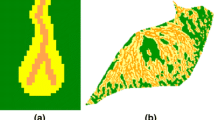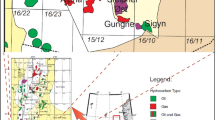Abstract
During longwall mining, the intact strata start to deform and fracture as the mining face progresses. Gob gas ventholes (GGVs) are drilled from the surface over a longwall panel before mining to capture methane from the fractured zone. Due to fracturing and bedding-plane separations, reservoir properties change extensively. This poses a major problem for venthole designers and methane control engineers and may become a safety and health concern for underground work force due to unexpected methane emissions: it is difficult to predict the location of major strata separations and their temporal magnitudes to best locate the ventholes. Measurements obtained at different times during longwall mining may not be helpful for this purpose as strata deformation is a dynamic process and the results from different tests may not be lumped together to analyze the data collectively. This article uses a combination of Monte Carlo (MC) simulation and well testing methods to analyze multiple data sets obtained from a GGV at different longwall face locations. The aim was to determine the magnitude of average strata separation before conducting well test analyses to determine the properties of a deformed reservoir. MC simulation was used to process cross-correlated and uncertain data distributions obtained from measurements to generate a set of normally distributed values for each data type. These values were further used to project the amount of strata separation to the timing of well test. Finally, well-test analyses were used to interpret test data and to evaluate reservoir properties.
Similar content being viewed by others
Abbreviations
- B g :
-
Formation volume factor
- c :
-
Compressibility (kPa−1, psi−1)
- h :
-
Net pay (m, ft)
- k :
-
Permeability (md, md)
- kh:
-
Flow capacity (md.m, md.ft)
- k/μ:
-
Mobility
- kh/μ :
-
Transmissivity
- P :
-
Pressure (kPa, psia)
- w :
-
Channel thickness (m, ft)
- q j :
-
jth flow rate (m3/d, bbl/d)
- q n :
-
nth flow rate (m3/d, bbl/d)
- r e :
-
External radius or radius of investigation (m, ft)
- r w :
-
Wellbore radius (m, ft)
- s :
-
Apparent skin factor
- t :
-
Time (h, h)
- t a :
-
Pseudo-time (h, h)
- t n :
-
nth flow period or superposition time
- Ψ:
-
Pseudo-pressure for gas (kPa2/Pa.s, psia2/cp)
- f:
-
Formation or flowing
- g:
-
Gas
- i:
-
Initial
- w:
-
Wellbore
References
Alper J.S., Gelb R.I.: Standard errors and confidence intervals in nonlinear regression: comparison of Monte Carlo and parametric statistics. J. Phys. Chem. 94, 4747–4751 (1990)
Bourdet D.: Practical aspects of well-test interpretation. In: Cubitt, J. (eds) Handbook of Petroleum Exploration and Production, pp. 351–375. Elsevier, Amsterdam (2003)
Clifford P.: Monte Carlo methods. In: Stanford, J.L., Vandeman, S.B. (eds) Methods of Experimental Physics, vol 28, pp. 125–153. Academic Press, London (1994)
Dake L.P.: Fundamentals of Reservoir Engineering, pp. 443. Elsevier, Amsterdam (1978)
Earlougher R.C.: Advances in Well Testing, pp. 264. Society of Petroleum Engineers of AIME, Dallas, TX (1977)
Engler T., Tiab D.: Analysis of pressure and pressure derivative without type curve matching, 4. Naturally fractured reservoirs. J. Petrol. Sci. Eng. 15, 127–138 (1996)
Escobar F.H., Ibagon O.E., Montealegre M.M.: Average reservoir pressure determination for homogeneous and naturally fractured formations from multi-rate testing with the TDS technique. J. Petrol. Sci. Eng. 99, 204–212 (2007)
Fekete Associates.: F.A.S.T. WellTest v. 7.1.1. http://www.fekete.com/software/welltest/description.asp (2009)
Horne R.N.: Modern Well Test Analysis, pp. 183. Petroway Inc., Palo Alto, CA (1990)
Huang H., Hassan A.E., Hu B.X.: Monte Carlo study of conservative transport in heterogeneous dual-porosity media. J. Hydrol. 275, 229–241 (2003)
Karacan C.Ö.: Reconciling longwall gob gas reservoirs and venthole production performances using multiple rate drawdown well test analysis. Int. J. Coal Geol. 80, 181–195 (2009a)
Karacan C.Ö.: Reservoir rock properties of coal measure strata of the Lower Monongahela Group, Greene County (Southwestern Pennsylvania), from methane control and production perspectives. Int. J. Coal Geol. 78, 47–64 (2009b)
Karacan C.Ö., Esterhuizen G.S., Schatzel S.J., Diamond W.P.: Reservoir simulation-based modeling for characterizing longwall methane emissions and gob gas venthole production. Int. J. Coal Geol. 71, 225–245 (2007)
King G.R., Ertekin T., Schwerer F.C.: Numerical simulation of the transient behavior of coal-seam degasification wells. SPE Form. Eval. 1, 165–183 (1986)
Krishnamoorty K.: Handbook of Statistical Distributions with Applications, pp. 346. Chapman and Hall/CRC, Boca Raton, FL (2006)
Kuchuk F.J., Onur M.: Estimating permeability distribution from 3D interval pressure transient tests. J. Petrol. Sci. Eng. 39, 5–27 (2003)
Lee J.: Well Testing, pp. 159. Society of Petroleum Engineers of AIME, Dallas TX (1982)
Looney S.W., Gulledge T.R. Jr.: Use of the correlation coefficient with normal probability plots. Am. Stat. 39, 75–79 (1985)
Matthews C.S., Russell D.G.: Pressure Buildup and Flow Tests in Wells, pp. 172. Society of Petroleum Engineers of AIME, Dallas, TX (1967)
Mazza, R.L., Mlinar, M.P.: Reducing methane in coal mine gob areas with vertical boreholes. U.S. Department of the Interior, Bureau of Mines, Research Report No. 1607-1-77, Pittsburgh, PA (1977)
Mohaghegh, S., Ertekin, T.: A type-curve solution for coal seam degasification wells producing under two-phase flow conditions. In: Proceedings of 66th Annual Technical Conference and Exhibition of Society of Petroleum Engineers, Dallas, TX (1991)
Nashawi I.S.: Pressure transient analysis of infinite-conductivity fractured wells producing at high flow rates. J. Petrol. Sci. Eng. 63, 73–83 (2008)
Oliver D.S.: The averaging process in permeability estimation from well-test data. SPE Form. Eval. 5, 319–324 (1990)
Palchik V.: Locatization of mining-induced horizontal fractures along rock layer interfaces in overburden: field measurements and prediction. Environ. Geol. 48, 68–80 (2005)
Ramey H.J. Jr.: Short-time well test data interpretation in the presence of skin effect and wellbore storage. J. Petrol. Technol. 22, 97–104 (1970)
Ren, T.X., Edwards, J.S.: Goaf gas modeling techniques to maximize methane capture from surface gob wells. In: De Sauza, E. (ed.) Mine Ventilation, pp. 279–286. Swets and Zeitlinger B.V., Lisse, The Netherlands (2002)
Structured Data: RiskAMP: Risk Analysis and Modeling Program. www.riskamp.com (2008)
Sheng J.J.: A new technique to determine horizontal and vertical permeabilities from the time-delayed response of a vertical interference test. Transp. Porous Media 77, 507–527 (2009)
Tomita, S., Deguchi, G., Matsuyama, S., Li, H., Kawahara, H.: Development of a simulation program to predict gas emission based on 3D stress analysis. In: 30th International Conference of Safety in Mines Research Institutes, South African Institute of Mining and Metallurgy, pp. 69-76 (2003)
Valvatne P.H., Serve J., Durlofsky L.J., Aziz K.: Efficient modeling of nonconventional wells with downhole inflow control devices. J. Petrol. Sci. Eng. 39, 99–116 (2003)
Whittles D.N., Lowndes I.S., Kingman S.W., Yates C., Jobling S.: Influence of geotechnical factors on gas flow experienced in a UK longwall coal mine panel. Int. J. Rock. Mech. Min. Sci. 43, 369–387 (2006)
Whittles D.N., Lowndes I.S., Kingman S.W., Yates C., Jobling S.: The stability of methane capture boreholes around a longwall coal panel. Int. J. Coal Geol. 71, 313–328 (2007)
Zuber M.D.: Production characteristics and reservoir analysis of coalbed methane reservoirs. Int. J. Coal Geol. 38, 27–45 (1998)
Author information
Authors and Affiliations
Corresponding author
Rights and permissions
About this article
Cite this article
Karacan, C.Ö., Goodman, G.V.R. Monte Carlo Simulation and Well Testing Applied in Evaluating Reservoir Properties in a Deforming Longwall Overburden. Transp Porous Med 86, 415–434 (2011). https://doi.org/10.1007/s11242-010-9628-2
Received:
Accepted:
Published:
Issue Date:
DOI: https://doi.org/10.1007/s11242-010-9628-2




